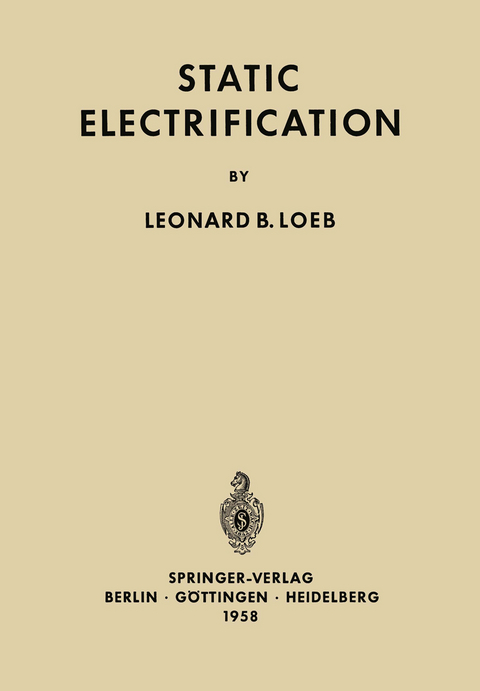
Static Electrification
Springer Berlin (Verlag)
978-3-642-88245-6 (ISBN)
I. Static electrification by electrolytic process.- A. Basic principles in terms of galvanic action from metal surfaces.- B. Nature of systems leading to charge separation and their limitations.- C. Do adequate aqueous surface films exist for electrolytic charging ?.- D. Past evidence of electrolytic charging.- E. Electrical endosmosis, streaming potentials, and cataphoresis (Verified aspects of electrolytic charging).- F. The more accurate calculation of the double layer characteristics including ions of both signs.- G. The Workman-Reynolds freezing potential.- H. Summary and conclusions.- II. The contact potential difference or volta potential.- A. Introduction.- B. The metallic state energy bands, the Fermi law and basic principles.- C. Surface structure and the work function in relation to the Fermi level.- D. Influences modifying the work function.- E. The contact potential difference.- F. The measurement of contact potential and/or work function.- G. Discussion and conclusion.- III. Static charging by spray electrification.- A. Introduction.- B. The Existence of an electrical double layer at gas-liquid interfaces.- C. Relative potentials in double layers of water in relation to surface tension, for salt, acid and organic solutes.- D. The spray electrification phenomena.- E. Spray electrification of water in relation to thunderstorm electrification.- F. Homogeneous or symmetrical charging of liquid droplets on dispersion.- G. Asymmetric charge distribution of droplets of micron size from bursting of small air bubbles in concentrated solutions.- H. Conclusions.- IV. Mechanisms of electrification on solid-solid contact.- A. Introduction.- B. Quantitative measuring techniques and the influence of electrical fields.- C. Initial investigation of controlled contact electrification of metal-inorganic insulator systems.- D. Electrification of dusts on dispersion and impact on surfaces.- E. The contact charging by rolling of inorganic insulator spheres on metal surfaces.- F. Extension of Peterson's investigations by Wagner.- G. Contact charging of ice on ice.- H. Other possible charge transfer mechanisms.- V. The generation of static charges by processes involving ionization of gases and miscellaneous other matters.- A. Introduction.- B. Various gaseous electronic mechanisms.- C. Static elimination.- D. Thunderstorm electrification.- E. Protection against lightning stroke.- Author Index.
| Erscheint lt. Verlag | 29.4.2012 |
|---|---|
| Zusatzinfo | XII, 240 p. 20 illus. |
| Verlagsort | Berlin |
| Sprache | englisch |
| Maße | 170 x 244 mm |
| Gewicht | 447 g |
| Themenwelt | Naturwissenschaften ► Physik / Astronomie ► Elektrodynamik |
| Naturwissenschaften ► Physik / Astronomie ► Optik | |
| Schlagworte | Energy • Fields • magnetism • metals • Modern Physics • Physics • Plasma • Radiation |
| ISBN-10 | 3-642-88245-5 / 3642882455 |
| ISBN-13 | 978-3-642-88245-6 / 9783642882456 |
| Zustand | Neuware |
| Haben Sie eine Frage zum Produkt? |
aus dem Bereich


